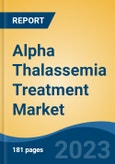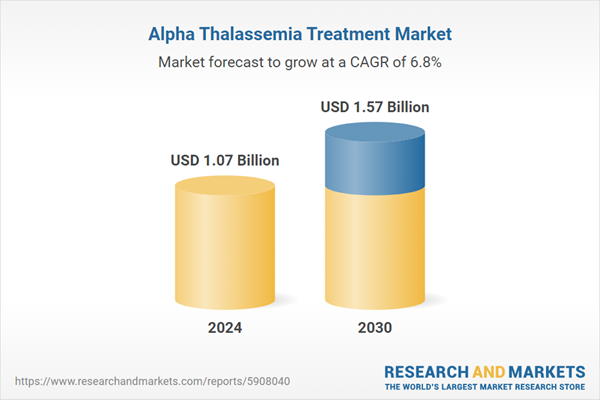Speak directly to the analyst to clarify any post sales queries you may have.
10% Free customizationThis report comes with 10% free customization, enabling you to add data that meets your specific business needs.
This leads to an imbalance in the production of hemoglobin, the protein responsible for carrying oxygen in red blood cells, causing anemia and other health complications. The market for alpha thalassemia is driven by several factors. Firstly, the global prevalence of thalassemia, including alpha thalassemia, is relatively high, especially in countries around the Mediterranean, the Middle East, Southeast Asia, and parts of Africa.
This high prevalence creates a substantial patient population in need of diagnosis and treatment. Advancements in genetic testing and diagnostic technologies have improved the accuracy and accessibility of alpha thalassemia diagnosis, contributing to market growth. For instance, according to a 2024 article published in NCBI, around 5% of the global population carries the α-thalassemia trait. Clinically significant forms of the disorder are most prevalent in Southeast Asia.
Key Market Drivers
High Prevalence in Certain Regions
The high prevalence of alpha thalassemia in certain regions plays a pivotal role in boosting the Global Alpha Thalassemia Treatment Market. This hereditary blood disorder exhibits a notably elevated occurrence in specific geographic areas, primarily encompassing countries around the Mediterranean, the Middle East, Southeast Asia, and certain parts of Africa. In these regions, the frequency of genetic mutations responsible for alpha thalassemia is significantly higher compared to other parts of the world. This elevated prevalence results in a substantial and enduring patient population, driving the demand for diagnostic tests, therapeutic interventions, and comprehensive disease management solutions.For instance, according to a 2023 article published in NCB, alpha thalassemia mutations are highly prevalent in the Mediterranean and Middle Eastern regions. Research based on previous studies indicates that up to 40% of individuals in these populations carry the genetic mutation associated with the disorder. This high carrier rate contributes to an increased incidence of clinically significant alpha thalassemia cases in these regions. The findings highlight the need for enhanced genetic screening, early diagnosis, and effective management strategies to address the impact of alpha thalassemia in affected populations.
Key Market Challenges
Limited Awareness and Screening Programs
Alpha thalassemia is a genetic blood disorder that affects the production of hemoglobin, leading to anemia and other health complications. It is particularly prevalent in regions with a high prevalence of consanguineous marriages, such as Southeast Asia, the Middle East, and parts of Africa. While significant strides have been made in the field of healthcare, the global alpha thalassemia treatment market faces a critical obstacle: limited awareness and inadequate screening programs.One of the primary challenges in tackling alpha thalassemia is the lack of awareness about the disease among the general population. Many individuals in high-risk regions are unaware of their carrier status, which means they could pass the genetic mutation to their offspring unknowingly. This lack of awareness perpetuates the cycle of alpha thalassemia within affected communities and contributes to the disease's persistence.
The absence of comprehensive screening programs exacerbates the problem. Screening for alpha thalassemia is crucial for early detection and genetic counseling, which can help individuals make informed decisions about family planning. However, in many regions, screening programs are either non-existent or inadequately funded, limiting their reach and effectiveness. This results in a missed opportunity to identify carriers and provide them with the necessary information and support.
Key Market Trends
Advancements in Genetic Testing
Advancements in genetic testing have played a pivotal role in boosting the global alpha thalassemia treatment market. This progress in diagnostic technology has revolutionized the way healthcare professionals identify and manage alpha thalassemia, significantly improving patient outcomes. With the advent of advanced genetic testing methods, it has become possible to pinpoint the specific genetic mutations responsible for alpha thalassemia accurately. Traditional diagnostic methods relied on general blood tests and clinical symptoms, which often led to delayed or inaccurate diagnoses. However, the introduction of DNA-based tests, including polymerase chain reaction (PCR) and DNA sequencing, has allowed for the precise identification of alpha thalassemia mutations. These tests can distinguish between different subtypes of the disease, such as alpha thalassemia minor (carrier status) and more severe forms like hemoglobin H disease or Bart's hydrops fetalis syndrome.The benefits of these advancements are multifold. Firstly, they enable early and accurate diagnosis of alpha thalassemia, which is crucial for initiating timely interventions and genetic counseling. Secondly, these tests provide essential data for assessing disease severity and tailoring treatment plans to individual patients, optimizing the management of alpha thalassemia. The genetic testing has become an invaluable tool for family planning, helping at-risk couples make informed decisions about having children.
From a research and drug development perspective, the detailed genetic information obtained through these tests has opened up new avenues for targeted therapies. Researchers can now explore precision medicine approaches, developing treatments that address the specific genetic mutations responsible for each patient's condition. This has the potential to lead to more effective and less invasive treatments for alpha thalassemia.
Advancements in genetic testing have facilitated large-scale epidemiological studies, providing a clearer picture of the global prevalence and distribution of alpha thalassemia. This data is essential for healthcare policymakers and organizations to allocate resources effectively, implement screening programs, and improve access to care for affected populations.
Key Market Players
- Agios Pharmaceuticals, Inc.
- Actis Technologies
- Novartis Pharmaceuticals Corporation
- Global Calcium Pvt. Ltd.
- CHIESI Farmaceutici S.p.A.
- Taro Pharmaceutical Industries Ltd.
- Amgen Inc.
- Sun Pharmaceutical Industries Ltd.
- FRESENIUS SE & Co. KGaA
- Acceleron Pharma
Report Scope:
In this report, the Global Alpha Thalassemia Treatment Market has been segmented into the following categories, in addition to the industry trends which have also been detailed below:Alpha Thalassemia Treatment Market, By Type:
- Alpha Thalassemia Silent Carrier
- Alpha Thalassemia Carrier
- Hemoglobin H Disease
- Alpha Thalassemia Major
Alpha Thalassemia Treatment Market, By Treatment:
- Folic Acid Supplement
- Iron Chelators
- Blood Transfusion
- Stem Cell Transplant
Alpha Thalassemia Treatment Market, By End User:
- Hospitals & Clinics
- Ambulatory Care Centers
- Others
Alpha Thalassemia Treatment Market, By Region:
- North America
- United States
- Canada
- Mexico
- Europe
- France
- United Kingdom
- Italy
- Germany
- Spain
- Asia-Pacific
- China
- India
- Japan
- Australia
- South Korea
- South America
- Brazil
- Argentina
- Colombia
- Middle East & Africa
- South Africa
- Saudi Arabia
- UAE
Competitive Landscape
Company Profiles: Detailed analysis of the major companies present in the Global Alpha Thalassemia Treatment Market.Available Customizations:
With the given market data, the publisher offers customizations according to a company's specific needs. The following customization options are available for the report.Company Information
- Detailed analysis and profiling of additional market players (up to five).
This product will be delivered within 1-3 business days.
Table of Contents
Companies Mentioned
- Agios Pharmaceuticals, Inc.
- Actis Technologies
- Novartis Pharmaceuticals Corporation
- Global Calcium PVT LTD
- CHIESI Farmaceutici S.p.A.
- Taro Pharmaceutical Industries Ltd.
- Amgen Inc.
- Sun Pharmaceutical Industries Ltd.
- FRESENIUS SE & Co. KGaA
- Acceleron Pharma
Table Information
| Report Attribute | Details |
|---|---|
| No. of Pages | 180 |
| Published | March 2025 |
| Forecast Period | 2024 - 2030 |
| Estimated Market Value ( USD | $ 1.07 Billion |
| Forecasted Market Value ( USD | $ 1.57 Billion |
| Compound Annual Growth Rate | 6.7% |
| Regions Covered | Global |
| No. of Companies Mentioned | 10 |









